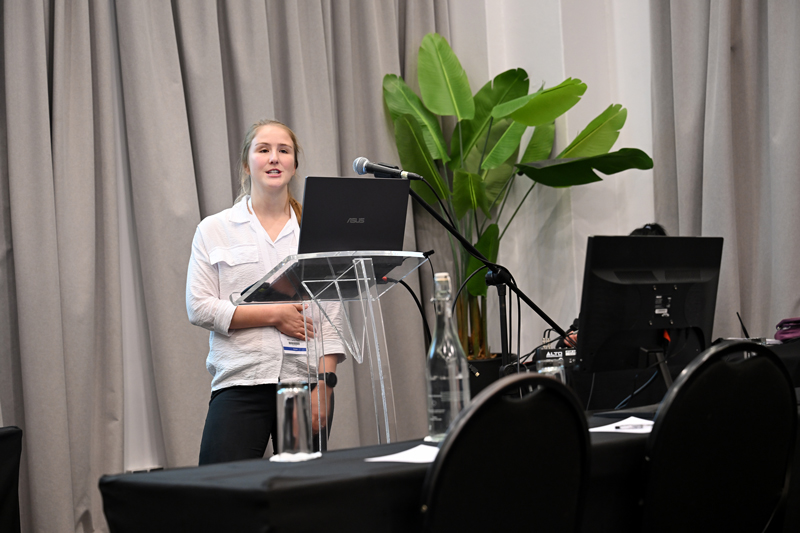Women’s rugby: Trends, tackles and technique
24 October 2024 | Story Kamva Somdyala. Photos Lerato Maduna. Read time 5 min.
Dr Sharief Hendricks – senior lecturer at the University of Cape Town’s (UCT) Division of Physiological Sciences – as the outgoing president of the South African Sports Medicine Association (SASMA) played host to the SASMA Congress, held in Stellenbosch from 17 to 19 October.
The congress brought together a multidisciplinary cohort of professional and scientific sports medicine gurus and students who presented on injury and illness prevention and management, concussion, physical activity, exercise and health promotion, sports nutrition, paediatrics and exercise, the female athlete, long-term athlete welfare, Olympic and Paralympic medicine, clinical case and more.
It was held under the theme “Breaking Boundaries in Sport Medicine and Science” and Dr Hendricks had the opportunity to observe some of his PhD and master’s students present on, among other topics, tackle and injury mechanisms as it pertains to women’s rugby.

Lara Paul: Injury events and mechanisms across age groups in South African female rugby union players
Rugby is categorised by high-speed running and frequent physical contexts such as scrums, rucks, tackles and mauls. “These are physically demanding and have a high degree of psychological and technical proficiency. An inability to fulfil the physical, psychological and technical demands of these contexts during a match or over a season exposes players to risk of injury,” Paul said.
“Over the last decade, women’s rugby has experienced rapid growth to approximately 2.7 million women rugby players globally. Although the sport is changing, it is predominantly a male dominated sport.”
She has spent time going over studies published on women’s rugby injury surveillance, going to as young as high school learners. One study, she explained, investigated injuries and concussions in female high school rugby over two years and they found that the tackle event had the highest cause of injury, which was 70% of match injuries.
“The tackle event the tacklers role accounted for 34% of all injuries; followed by the ball carrier at 26% of injuries and open play at 16%.”
“Colleagues and I have also published a report on the South African Rugby Union (SARU) girls’ youth week in 2022, which focused on U16 and U18 level and we found in the tackle event the tacklers role accounted for 34% of all injuries; followed by the ball carrier at 26% of injuries and open play at 16%.”
At senior level, the authority looks at six seasons at senior elite level. The tackle event was the highest cause of injuries at 41%. The snapshot shows that the tackle event is the highest cause of injury events across groups, which is not surprising.
Paul concluded: “Therefore, understanding women’s injury trends not only allows researchers and practitioners to make the sport safer, but allows for the development of injury prevention programmes and strategies that are tailored to the women’s game, thus improving this developmental pathway.”

Seipati Rasenyalo: Can a tackle technique training programme improve tackling ability in women’s rugby? A pilot study
The men’s side of the game so far as tackle technique goes is spoilt for choice, while there are still some studies that need to be done on the women’s side of things, Rasenyalo has observed. “World Rugby’s tackle-ready programme offers a technical tackling guide, but it is not widely adopted. Authorities back the claim that there should be more women-specified coaching in technique,” he said.
“To delve into the study, I engaged in capacity testing where the players need to tackle until they are fatigued; they are coached during the sessions on which shoulder to use in the tackle, then we review the session, followed by a proficiency test, which looks at whether they did the capacity test correctly: in other words, techniques needed for a tackle including height into tackle and what happens post engaging in the tackle: was the tackle explosive, for example.”
Rasenyalo added: “This year we worked with the U20 group over a six-week period (ended up being five because of Cape Town weather). What I picked up is the players were willing to learn and are open-minded because they want to improve themselves.”

Natalie Erskine: Trends in rugby union research: A biometric analysis
Erskine’s objective was to identify key areas of research within the rugby union and understand how these focus areas have changed between 2016 and 2022. “To achieve our goal and focusing on the aforementioned period, the criteria was that they had to be peer-reviewed studies in health, sport science or exercise medicine and their focus on rugby union. Once we had our papers, we did a keyword analysis and to do that, we had to extract all the keywords from the papers by extracting the author-assigned keywords and the title.”
What’s more, they created keyword networks for each year and because there are a lot, the team highlighted the top 20 keywords for each year. To analyse the networks, they looked at centrality (how influential the keyword is within a network), and looked at the frequency a word appears in a publication.
“The number of studies rose each year from 2016 to 2022. And there was keyword growth yearly, indicating an expanding scope of research. The most prominent words included concussion, and this highlights the growing concern over head injuries and their long-term effects. Performance was another, showing the drive to optimise player capabilities through training and monitoring. Injury prevention was another, as well as global positioning systems (GPS), facilitating the betterment of more targeted training programmes,” Erskine added.
The congress was attended by over 350 delegates, included 120 poster presentations, 10 student presentations, eight clinical cases and 28 oral presentations, with Hendricks declaring the congress a success.
 This work is licensed under a Creative Commons Attribution-NoDerivatives 4.0 International License.
This work is licensed under a Creative Commons Attribution-NoDerivatives 4.0 International License.
Please view the republishing articles page for more information.










